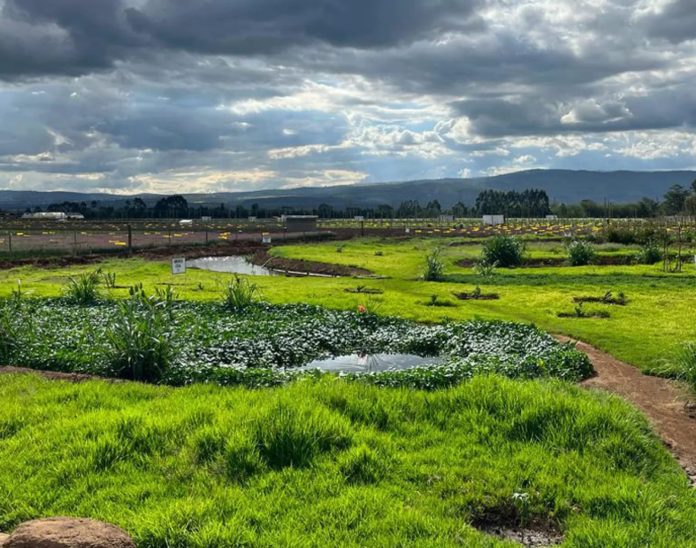“Marginpar is not just about flowers. Environmental sustainability is very important to us. We are a proud member of the Floriculture Sustainability Initiative (FSI) and aim to achieve 100 per cent sustainable production for all our flowers”, said co-CEO Richard Kiki Fernandes.
The group’s sustainability story is best exemplified at this point in time at the newly constructed wetland, a beacon of innovation showcasing a sustainable and efficient approach to wastewater management that not only purifies water for re-use but also supports biodiversity.
Steve Mwaniki, the Environment, Social, and Governance (ESG) leader takes us through the beautifully designed landscape at Kariki Farm,Juja farm, the face of such landmarks spread across the Marginpar partner farms in Kenya and Ethiopia, Tanzania and Zimbabwe. The constructed wetlands embody commitment to eco-friendly operations. It is not the traditional wetlands we are used to but a state of the art design.
Collecting and Treating Wastewater
The journey of wastewater treatment at begins with a meticulous collection from the various points. These include the Central Spray Unit, where chemicals are mixed, the Central Fertigation Area, where fertilizers are prepared, and from everyday operations such as the pack house, canteen, laundry, and machinery washing areas. This comprehensive collection ensures that all potentially contaminated water is captured for recycling.
Initial Treatment Processes
The first stage of treatment involves an oil-water separator, which efficiently removes fats, oils, and grease. This pre-treated water then moves to deactivation pits containing charcoal and gravel, designed to break down plant protection and post-harvest products, rendering the wastewater safe for further treatment.
The Constructed Wetlands
The heart of the process lies in the constructed wetlands, which mimic natural water purification systems found in marshy areas or rivers. The system is composed of several stages, each playing a crucial role in purifying the water.
- Primary Holding Tank: Wastewater is stored in a large tank with four compartments, allowing solids to settle over two days. The settled sludge, classified as hazardous waste, is responsibly disposed of through the National Environment Management Authority -approved companies.
- Secondary Holding Tanks: The effluent is mixed with a special bacteria called OSP and molasses. This combination accelerates the breakdown of contaminants into nutrients that plants can absorb.
- Vertical Flow Bed (VFB): Leveraging gravity, water trickles through substrates that further break down chemicals, enhancing nutrient absorption.
- Horizontal Flow Bed (HFB): Water flows horizontally under the substrate, which is planted with various species known for their nutrient uptake capabilities. This stage includes gravel bed hydroponics, ensuring efficient nutrient removal.
- Surface Cells/Ponds: The water flows sequentially through five ponds, each populated with different types of hydroponic plants such as papyrus and arrowroots. These plants maximize the removal of remaining pollutants.
Biodiversity and Monitoring
As water moves through these stages, the system supports a thriving ecosystem. Surface cells four and five introduce aquatic life like fish, while frogs naturally inhabit the ponds, indicating a balanced and healthy environment. A unique aspect of the system is the use of Chinese lettuce as a bio indicator. By comparing the root lengths of lettuce in the first and last ponds, the team can assess nutrient levels, confirming the gradual purification of the water.
Ensuring Water Quality
Before the treated water is deemed suitable for irrigation, samples from the final pond undergo rigorous laboratory testing. If the water meets quality standards, it is pumped into a farm reservoir, which also stores rainwater and borehole water. Should the water require further purification, it is recirculated back to the VFB for additional treatment.
A Model for Sustainable Agriculture
Kariki Marginpar farm’s constructed wetlands are more than just a wastewater treatment facility; they represent a holistic approach to sustainable agriculture.
. By integrating natural processes with innovative technology, the farm not only addresses its water needs but also contributes to environmental conservation. This pioneering project highlights the potential for agricultural practices to harmonize with nature, setting a standard for other farms to follow. As Kariki Farm Marginpar continues to refine and expand this system, it paves the way for a future where sustainability and productivity go hand in hand.
This story of Kariki Juja Farm, told with precision, passion and knowledge serves as an inspiring testament to the power of innovation in achieving environmental stewardship and agricultural excellence. It also attests to the commitment, by the Kenya flower industry, to sustainable practices.

